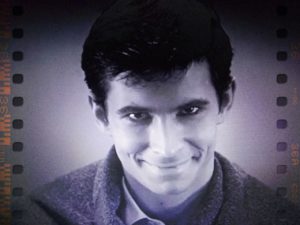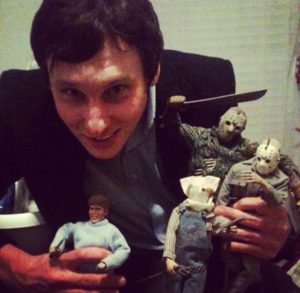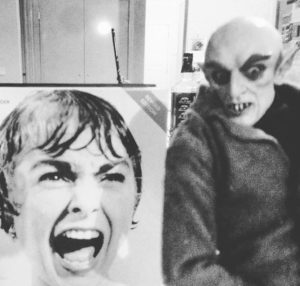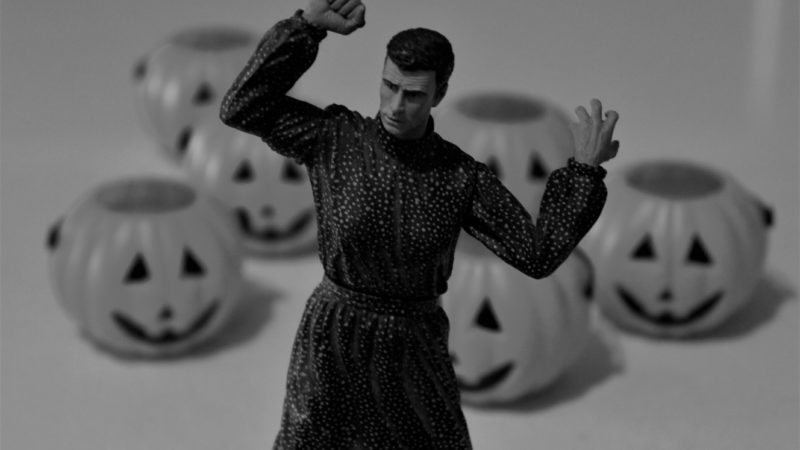THE PSYCHO WHO STOLE HALLOWEEN
How a film director’s goal in the late 70s simultaneously ruined two cherished horror movies.
Yeah that’s right, two pioneering movies of the horror genre were ruined for me this year and I’m still yet to determine where exactly to cast my anger. It all started while reading Jason Zinoman’s book Shock Horror, a sweet little number I came across in one of those pop-up book stores that didn’t exist six months ago and no longer exists today. The book focused on a different kind of film maverick of the seventies that would set the horror template for the next four decades via their gall for pushing the blood and guts boundaries to previously un-stomached lengths. Essentially the slashers had an agenda whereby they would reflect the horrors of the Vietnam War and the films of this nature that the author focused upon were by far the most progressive and enchanting. At the time I vowed to relive some of the knife-wielding originators that spawned from that famous shower scene in Psycho like The Last House On The Left and Halloween.
I never did get round to it and I guess the mood for onscreen killing doesn’t always strike but I’ve certainly been reminded recently with the abundance of Halloween merchandising screaming at me from shopping centres months before the night of trick or treating is even scheduled to take place. Since I don’t own The Last House On The Left as I can’t honestly foresee a day so rainy that I’ll be forced to put myself through such visual punishment ever again, I instead opted for my still sealed Blu-ray copy of Psycho and dug out an old DVD version of Halloween. I generally considered these two companion pieces anyway, at least in a crazed-killer-with-a-kitchen-knife sense, and also because Janet Leigh’s previously unknown daughter was hired for the latter… and they both feature a character named Sam Loomis.
But if there’s one thing I took away from Shock Value, it was a few lines in the book concerning both movies that has been nagging at me, the strength of which has pulled me out of the countless tense moments, essentially disallowing me to ever be swept away from these cinematic gems perhaps ever again. The horror mavericks of the time found a flaw in Psycho which they believed discredited the entire movie. A flaw that disputed exactly what the title suggests and it all centres around the final scene. Once revealed that the Psycho killer was in fact Norman Bates (mentally convinced he has inhabited his own dead mother) he/ she provides us with an internal monologue ensuring us that all violent behaviour will cease going forward now that he’s held captive in an insane asylum. All is right with the world once more and we can sleep soundly at night. This staple of the Hollywood ending is also a cop out of which should have been left on the cutting room floor argued the mavericks of the next generation. If you had taken away this need to put the audience at ease, Norman Bates would have been immortalised and rewarded as the coldest most calculating movie killer ever to grace the silver-screen let alone the partially forgotten motel he had inherited.
I love the movie in the most profound way and I certainly can’t recall ever dwelling upon its ending, at least not until now. By the time I first saw Psycho I hadn’t exactly been living under a rock and was quite aware that it contained a ridiculously famous shower scene. When the ear and skin splitting scene finally occurred before my eyes I was more beheld by the idea that this much heralded moment was happening on my TV screen rather than feeling any sense of shock or all-encompassing loss for our heroine and a plot we had just begun to invest in. The images that stay with me the most are far from the bathroom but rather, I immediately recall the victim’s car being lowered into the ground and the chilling way Bates smirks as the motorised piece of damning evidence finally disappears beneath the swamp. That precise moment insists we scrap whatever we knew previously for this movie’s no longer about stolen money. But frankly it’s the climax of which I was most unprepared, a scene that would leave me shuddering long after it disappeared from my TV. The look of bloody excitement on Norman Bates’ face when he enters his basement, dressed in full Mother Norma regalia and holding up the butchers’ knife towards his next victim. Firstly I was floored by the reveal of who was doing these killings and to witness him/ her in the act for it hadn’t previously been spoiled and secondly there’s just something uber-gothic about it all that continues to haunt – maybe it’s the black and white film and the swinging light globe projecting a filthy cellar while his mother’s exhumed corpse watches it all unfold. I’m usually so blindsided by this scene that by the time Bates is confined within the psycho-ward banging on about the justice of a fly, my mind’s still reeling over the previous encounter.

It’s a shame that I should dismiss an all-time favourite over a few lines in a book, for despite this recent inner-crisis as to how I feel about the plot, the fact remains that Psycho is truly a masterpiece one trickled with fascinating components to study and absorb. Endless themes of voyeurism from Bates to Hitchcock himself (as exploited by Anthony Hopkins in that movie), to the taxidermy hobby as the birds hanging on the walls that are metaphorically seeing through the eyes of the dead not unlike the corpse of Norma in the final scene. Even the relatively cheap production values (Hitchcock used his TV team from a recently successful ‘Hitchcock Hour’ program) add to its ambiance and Saul Bass’ famous opening credits take part in the action too (note which way Anthony Perkins title credits move as opposed to the other cast members). But for the next generation of horror filmmakers, this was a changing of the guard moment, the first link in the serial killer chain that would put the Vincent Prices of the wold out of business. Yet all I’m left with is a sense of wonder as to whether Hitchcock did do a disservice to his beautifully realised psychopath by hastening the blow in the conclusion.
By the same token in terms of my age, I was a late-comer to the Halloween phenomenon. I decided I wasn’t necessarily a fan of the franchise after my high-school friends and I distractedly binge-watched five sequels in one night and the movies all bled into one, but eventually I came round, if only to the original. Shock Value does like to hail Halloween for single-handedly perfecting a new type of on-screen killer, one that wears a mask preventing you to see into the eyes of the madman, a breathing embodiment of the metaphors of Psycho. A stealthy killer devoid of consciousness who cannot be reasoned with and stops at nothing particularly in the pursuit of promiscuous teens. The plot is less layered and complex than its predecessor, put simply it’s about Michael Myers, a crazy kid who kills sister and is locked up only to escape and wreak havoc as an adult. His all-knowing doctor traces him back to his original home town where Myers continues where he left off.
Halloween masterfully adopted the fear in the home theme, a sub-genre that Hitchcock most favoured aka Shadow Of A Doubt whereby bringing the madness to you as opposed to you stumbling upon it in a remote part of Texas or a long-forgotten motel. This seminal work also paved the way for iconic masked 80s killers with household names like Jason Vorhees and Freddy Kruger. But before sequels and remakes would over-indulge in backstory and find superfluous meaning in such heinous motives, the kind of nonsense these filmmakers detested, Halloween is the perfect depiction of an on screen killer and its brilliance lies within answers that we have not been granted.
The problem is that where before I felt the presence of Psycho in everything from production values, to music to cast whereas now I have the distinct impression that the primary person responsible for bringing killer Michael Myers to life – Director John Carpenter, was not only out to remake Psycho for a bolder audience but rather he was out to correct and get it right, I dare say to amend Hitchcock’s wrongs.

So I went back and re-watched these two films back to back and sure enough these films have now been tainted thanks to a mere mention in a horror book. Sure Zinoman was only reporting the facts after extensive research and interviews with his muses, but in doing so he’s left an impression that I’m unwilling to shake. One movie’s flawed and the other is not paying tribute as I so often assumed but is on a war-path for improvement. What sux above all is that I’m too easily swayed and genuinely felt that Psycho and Halloween had suddenly become altered beyond repair while I tried so desperately to enjoy them the way I always have.
So does Halloween succeed in dethroning Psycho? Personally I think you can’t out master the master of suspense (as Gus Van Zandt’s remake of Psycho certainly proved) and aesthetically, that shower scene rests victorious in a cinematic kingdom unto itself, but the issues are centred around how effective are the killers and who reigns supreme as the most soulless and hollow predator. Before “showering” Hitchcock with my praises once more since I will always opt for Psycho as the better film, I started to think otherwise when comparing the two leading men in a universal sense.
A minor revelation occurred to me as to which killer is I guess more iconic while I stared at one of my toys. Let me explain – during my horror movie awakening somewhere around high school I decided that all I wanted for Christmas and birthdays was to own the dolls. The bigger the better and my accommodating mum saw that such desires were met. They still look immaculate and I treasure these detailed and eerily life like executioners to this day. Leatherface, Count Orlock and Jason Vorhees (in several eras and forms) have moved house with me over the years and I still can’t help but chuckle at the thought of my mum entering a collectable store and buying these eye-sores in their bulky blood-splattered boxes which usually showcase printed images of the iconic killer in action. I’d give anything to have heard her utter the words ‘One Jason Vorhees from Friday The 13th Part 2, with bag-on-head my good man!’ although I’m sure this exchange is inaccurate but rather, a polarised mum out of her comfort zone would have awkwardly pointed to the specific killer looming from behind the counter, paid quickly then attempted to flee the scene throwing the box in the getaway car.

One year mum was torn as to which killer I would want next, no doubt secretly hopeful that this phase was drawing to a close. She asked my friend Bell, the very friend who turned me specifically onto the horror of the 80s and its key players in the first place. Mum pointed out that she had come across two magnificent horror specimens that I was yet to own but figured I would appreciate none the less. The choice was out of two white faced monsters, Pinhead, the pinheaded, otherworldly cloaked figure from the Hellraiser series, or Michael Myers aka The Shape aka the tweaked William Shatner mask from Halloween. When Bell ruined the surprise by explaining mums conundrum of choice, I either thought or verbally cut him off by saying ‘you said Michael Myers yeah?’ He had chosen Pinhead for me. I was hardly disappointed for as a fan even though I preferred Halloween it certainly wasn’t mum or Bells’ fault. Hell, I’d seen Hellraiser countless times despite the fact that I still never understood what was going on, but at that moment the heart wanted Myers.

Flash forward or even backwards (it’s irrelevant) to when I purchased a Norman Bates doll. Again I was with my friend Bell and it was a bad day for a spot of nerd shopping as we would call these ventures. First we went to a small city store that specialised in hard to-find / yours-to-own VHS or perhaps primitive incarnations of DVD. We were young and generally excitable when it came to previously undiscovered movies in the Home Video format. Amidst our boyish racket the store owner approached us and insisted we ‘don’t make fun of the movies’. Bell immediately retaliated ‘we’re not, we like these movies’. I think what happened was that we were in the proximity of the Gay and Lesbian section and the misunderstanding was that we were teasing his shelf in jocular fashion. In fact I made a selection from the gay section that day, I purchased Glen or Glenda for at the time I was on the hunt for movies that predominantly featured in the film Edwood. But being told off in what I otherwise felt was a haven left a bad taste in my mouth.
Next we went to the Collectibles store where I saw for the first time a Norman Bates doll which being the Hitchcockian disciple that I was, felt the need to impulsively buy it on the spot. Quite the reverse of the previous encounter the shop assistant started teasing me for my purchase loudly announcing to the entire store ‘Ah, man in a dress doll!’ as he removed it from the shelf behind the counter. To this day Bell still refers to Bates as man-in-a-dress-doll whenever he sees it on display at home. But what I later realised is that the store guy wasn’t making a slight at my perceived sexuality nor was he making a grander statement against the transgender community. This had nothing to do with the movie Psycho either. It was merely the fact that a man wearing a dress in the realm of gruesome horror toys was pretty unremarkable. If you remove the film connotation at all, it hardly screams terror but just an odd thing to want to own. If I had purchased Michael Myers that day not a word would have been uttered, certainly not one of ridicule anyway, because let’s face it, visually Michael Myers is just, I don’t know… cool.
Considering the iconic legacy of the killers via their toys I guess Halloween does succeed, it certainly reigns over man-in-a-dress-doll. In the grand scheme of things Carpenter exceeded Hitchcock in that he constructed a chillingly hollow and merciless killer with an unmistakable look and he brought this terror right into the home which is exactly what the director wanted to achieve. Then you consider a murder moment for each – when Bates kills he transforms back into his rather jerky, pathetic and gratingly apologetic self, whereas the other requires less dramatics– when Myers kills he stands by and admires his handiwork thus proving he is a far more sinister and shameless beast. But the reality is that I will always watch Psycho with an unspoken sense of what if – or how would the movie fare if we erased that final scene? And I will forever watch Halloween as a tale with a competitive streak essentially ruining what blissful ignorance I had harboured in the past. Happy Halloween… I suppose.
